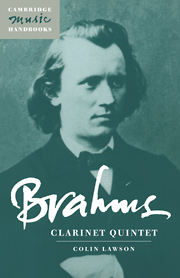Book contents
- Frontmatter
- Contents
- List of illustrations
- Preface
- 1 The nineteenth-century clarinet and its music
- 2 Brahms and the orchestral clarinet
- 3 Brahms's chamber music before 1891
- 4 The genesis and reception of the Clarinet Quintet
- 5 Design and structure
- 6 Performance practice
- 7 The legacy of Brahms's clarinet music
- Appendix 1 A list of Brahms's chamber music
- Appendix 2 A review of the first London performance,The Times,29 March 1892
- Appendix 3 The mechanism of Mühlfeld's Baermann-Ottensteiner clarinets
- Notes
- Select bibliography
- Index
1 - The nineteenth-century clarinet and its music
Published online by Cambridge University Press: 05 June 2012
- Frontmatter
- Contents
- List of illustrations
- Preface
- 1 The nineteenth-century clarinet and its music
- 2 Brahms and the orchestral clarinet
- 3 Brahms's chamber music before 1891
- 4 The genesis and reception of the Clarinet Quintet
- 5 Design and structure
- 6 Performance practice
- 7 The legacy of Brahms's clarinet music
- Appendix 1 A list of Brahms's chamber music
- Appendix 2 A review of the first London performance,The Times,29 March 1892
- Appendix 3 The mechanism of Mühlfeld's Baermann-Ottensteiner clarinets
- Notes
- Select bibliography
- Index
Summary
An integrated model: Mozart's Clarinet Quintet
There are some striking parallels between the clarinet quintets of Mozart and Brahms, unquestionably the two greatest works for the medium. For example, Mozart directly anticipates Brahms in his expression of underlying melancholy, whilst integrating the clarinet with the string texture to a remarkable degree. Any survey of the nineteenth-century clarinet and its music must necessarily take as its starting point the remarkable collaboration between Mozart and Stadler, which inspired a host of other smaller pieces besides the Clarinet Quintet and the Concerto. Mozart's Quintet for piano and winds and his Clarinet Trio also feature the instrument within new genres in textures far removed from the concertante style which dominated wind writing of the period. The relationship of Mozart and Stadler parallels to an uncanny degree the meeting of Brahms and Richard Mühlfeld in 1891; a further link is that it was Mühlfeld's performance of Mozart's Quintet which played a major part in inspiring Brahms to begin work on his own Clarinet Quintet.
Mozart's works are of the utmost importance in the history of the clarinet's development; they represent the culmination of a century in which the instrument developed from its origins c. 1700 into a fullyfledged solo voice. By Mozart's day, the cantabile possibilities of the instrument were increasingly recognised, the B♭ instrument rather than the clarinet in A or C having become established as the favourite solo instrument in concertos of the Mannheim school by Johann and Carl Stamitz, Dimler, Eichner and others.
- Type
- Chapter
- Information
- Brahms: Clarinet Quintet , pp. 1 - 12Publisher: Cambridge University PressPrint publication year: 1998



